Northwold Estate, in the London Borough of Hackney, was recently informed that the Guinness Partnership, one of the largest housing associations in Britain, and which took over the running of the estate from the Labour Council seven years ago, were now looking at options for its regeneration. These are:
- Infill, building new flats on unused land on the estate;
- Partial demolition and redevelopment of the estate;
- Full demolition and redevelopment of the estate.
The first consultation, which is being conducted by the firm of Newham Francis in collaboration with TM Architects, was held on 28 July, with a second held shortly afterwards on 17 August. A total of 130 residents from the roughly 1,700 that live on the estate attended these events. Despite this, residents have been informed that the Guinness Partnership will be presenting its proposals for their estate at the end of September, a mere two months from the initial consultation.
The declared aim of the regeneration is to ‘build more homes’ and ‘create mixed communities’. However, leaving aside the fact that housing estates are already some of the most mixed communities in London, we know from the example of the full demolition and redevelopment of the Loughborough Estate in Brixton what protocol the Guinness Partnership is likely to follow.
Leaseholders will be offered compensation for their homes and encouraged to move off the estate rather than go through the ten years it will take to decant residents, demolish the existing homes and build the new ones. If they still wish to return to the new development, the compensation they can expect to receive in return for their demolished homes will barely be enough to allow them to enter into shared equity or joint ownership, effectively turning homeowners into renters.
Secure tenants, meanwhile, who are currently being told that they will be rehoused in the new flats within two years – a blatantly false statement – will find that when the time comes they will be offered nothing more than the Right to Return to the new developments if they can afford the hugely increased rents. Large numbers will accept offers to be re-housed elsewhere in the borough, or more likely further out, and their current homes will either be left empty, filled with new tenants on assured short-terms tenancies, or, as was widely practiced on the Loughborough Estate, occupied by property guardians. As a consequence, when the time finally comes to establish the tenancy mix in the new development, the number of flats set aside to accommodate residents on secure tenancies will have been drastically reduced.
Even then, what tenants haven’t been told by the Guinness Partnership is that under the Government’s Housing and Planning Act 2016, there is now no longer any requirement for new housing developments to contain any homes for social rent, and that, as a consequence, Labour Councils across London are replacing their promises to do so with so-called ‘affordable housing’. As is increasingly widely known by now, this means up to 80 per cent of market rate, and in Hackney the average rent for a 1-bedroom flat is currently £1,500 per month, over £1,900 for a 2-bedroom flat, and nearly £2,700 for a 3-bedroom flat. These figures, however – which are totally unaffordable for the majority of tenants on Northwold Estate – are only the average rent, and considerably less than the prices they can expect to be offered on the luxury flats the Guinness Partnership want to build. This, and not the lies with which they are being placated, is the real, financial context of tenants’ and leaseholders’ Right to Return to the new development – which is the only right they will be guaranteed.
Faced by these facts, all of which add up to a programme for the social cleansing of the Northwold estate community, a group of residents – both leaseholders and tenants – have started a campaign to defend their homes and their community from the Guinness Partnership and Hackney Labour Council. Refusing the options they have been offered without prior consultation, their demand is for:
- The maintenance of the existing estate;
- The retention of the borough’s rapidly dwindling stock of social housing;
- The continued residency and tenancy status of the existing community on Northwold Estate.
Please give your active support to the Northwold Estate campaign: @savenorthwoldE5


Initially built in 1938, Northwold Estate now contains 580 council flats, of which 140 leasehold were purchased through the Right to Buy before the estate was bought by the Guinness Partnership, providing homes for around 1,700 residents. Despite a lack of maintenance since the refit in the early 2000s, the buildings are structurally sound and the homes in a decent state of repair.

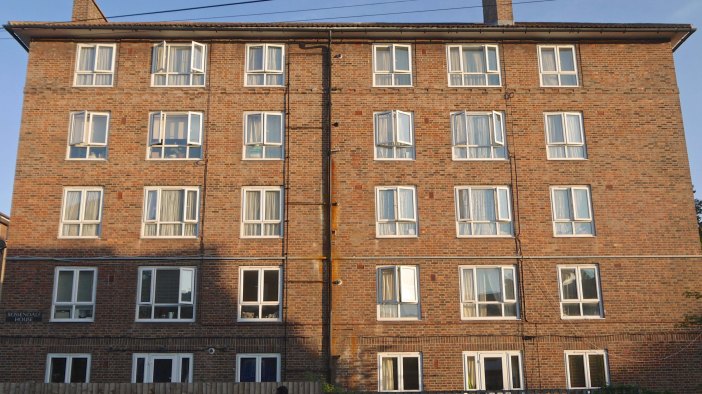
Additional mansion blocks, updated in style but in keeping with the look of the overall estate, were added in the 1950s, increasing the number of council homes for Hackney’s largely working-class population.


The external lifts were added in the 1980s, and new playgrounds in some of the forecourts allow children to be watched over by parents from the kitchen windows of the flats above. Despite this, these flats do not meet modern home standards, and therefore cannot be gutted and refurbished as luxury apartments. So despite the appearance of choice, full demolition and redevelopment – which is also the most profitable course of action for developers – is the only option the Guinness Partnership will be genuinely considering, as their employment of TM Architects indicates. However, like the hundreds of thousands of Georgian and Victorian conversions in which millions of Londoners live, this failure to meet modern housing standards does not mean the estate that 1,700 residents call home is no longer ‘fit for purpose’. Nor does it justify its demolition in the middle of a housing shortage of homes in which Londoners can afford to live. On the contrary, what are not ‘fit for purpose’ are the hostels, bed-sits and other forms of temporary accommodation to which the bulk of the estate’s tenant households will be decanted with the promise of their return.
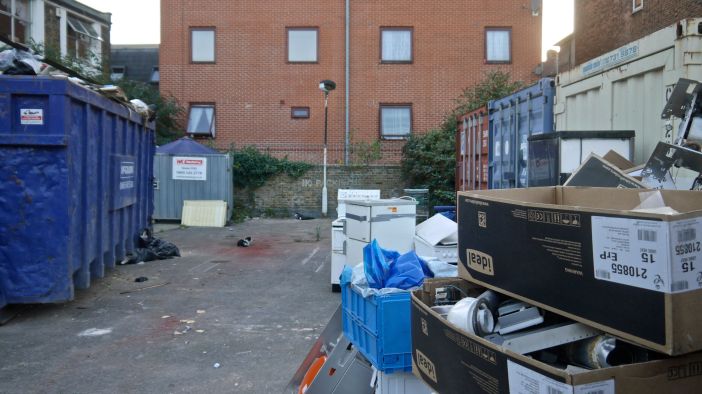

As part of the managed decline of the estate, vacant lots have been fenced off and used for rubbish collection, while garages, once in 24-hour use, have been run down into a state of disuse. Following the Housing and Planning Act, these now qualify as ‘brownfield land’, meaning any developer that proposes a housing development on the land will automatically be granted planning permission in principle.


The balconies of the mid-rise blocks have recently been painted white, a ruse often employed to convince residents that their homes are safe from the bulldozers.

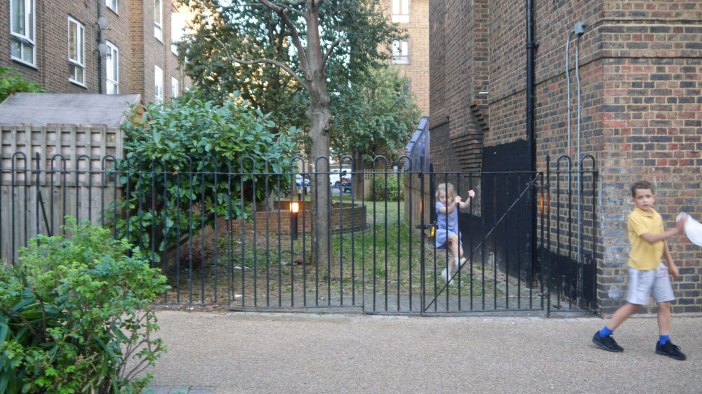
This garden courtyard between several blocks was recently closed on the grounds that it encouraged ‘anti-social behaviour’. Under the Antisocial Behaviour Crime and Policing Act 2014, this now encompasses anything that ‘has caused, or is likely to cause, harassment, alarm or distress to any person, or is capable of causing a nuisance or annoyance to a person.’ Despite this, when we visited the estate these children had climbed the fence and were enjoying the garden – an act of civil disobedience which, whether it causes a nuisance or not, we recommend their parents follow.
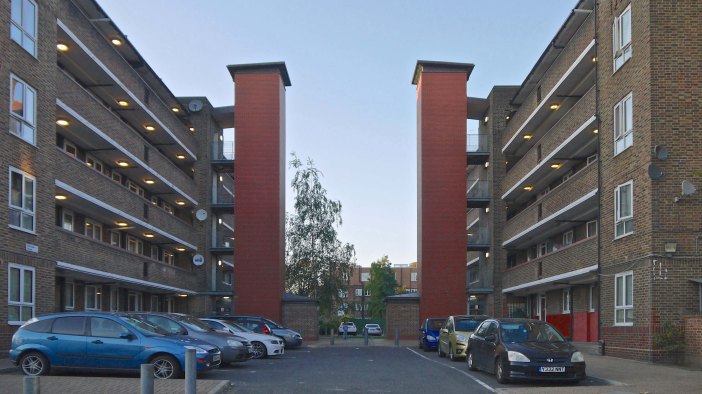

In a tactic employed on every estate across London facing ‘regeneration’, the community hall, which overlooks this playground, has been closed to residents – though it may still be booked on extortionate commercial rates. This effectively deprives the community of a place to organise resistance to the Guinness Partnership’s plans to demolish residents’ homes and drive them out of Hackney.


Northwold Estate has been designed as an urban village of mid-rise blocks around a large central square, precisely the type of architecture being promoted by the Government’s narrative of City Villages: More Homes, Better Communities. But it would seem that some villages and communities are considered better than others.

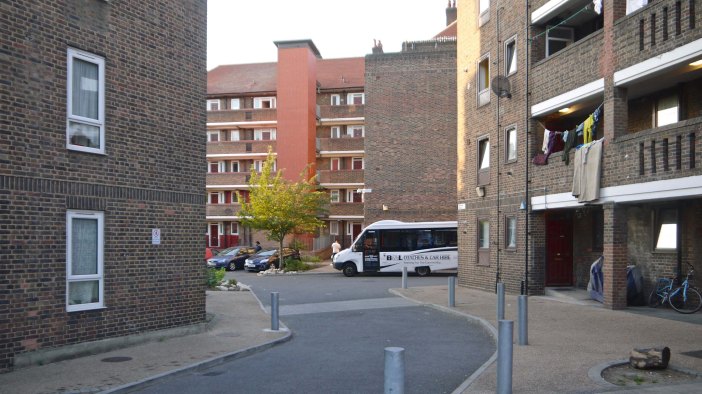
The estate plan is like a jigsaw of interlocking blocks, with smaller courtyards opening onto larger ones, giving each block an individual identity and unique relationship to the larger whole. Far from facing demolition, Northwold Estate should be adopted as a model for the kind of social housing London so desperately needs.


The external walkways act as balconies onto the interior courtyards, with plenty of space for parking, and numerous trees growing around the estate, providing an important environmental resource against air pollution.


A measure of the Guinness Partnership’s commitment to estate maintenance is the state of its Housing and Repairs Desk. No maintenance has been carried out for over 15 years. Like the garages and bin yards, this land has been fenced off from residents and can now be categorised as brownfield land. When planners draw their red lines around estates they want to demolish, the existence of red-lined blocks of land within the estate grounds acts as encouragement to the investors who will fund their demolition project.


The detailing in the brickwork of the estate demonstrates an attention to detail and pride in craftsmanship glaringly lacking from the generic, brick-clad facades of the ‘luxury housing’ being built on the demolished council estates of London – as a visit to the Guinness Partnership’s redevelopment on the former Loughborough Estate will confirm. ‘Glorified rabbit hutches’ was one tenant’s opinion of the new homes he’d been re-housed in.


Even on a high-density estate like Northwold, the inventive transitions between courtyards and blocks provide areas for formal and informal playgrounds where kids can play in safety away from cars and the street. It’s unlikely, of course, that any but the wealthiest parents will be able to afford the price of the luxury apartments the Guinness Partnership wants to build in their place. The bulk of the properties will be real estate investments by nom-domicile buyers and buy-to-let landlords.


The huge back gardens are home to mature trees planted 80 years ago when the estate was first built, none of which will survive its demolition and redevelopment, further depleting the environment.


The transition between the estate and the surrounding neighbourhood is managed through a row of lower blocks that harmonise well with the terraces opposite, and lead onto a grid of village-like side streets that combine car and pedestrian use.


The large sports facilities, which are used not only by children from the estate but by local football teams, will all be lost to a redevelopment whose bottom line is to maximise profits for investors by building the highest density of luxury apartments on as much land as possible.


Like all the land Northwold Estate stands on, the maintenance depot belongs to Hackney Council, and is part of the demolition plans of the Guinness Partnership. The housing association has the full co-operation of the Labour Council, which has already overseen the demolition of 18 council estates in Hackney with the loss of 915 homes for social rent and the construction of 3,343 flats for sale or rent at the full market price.


In an image of the estate’s future, this bland, generic block (above), built on former brownfield land, is private accommodation; and the estate pub (below), another community centre closed down, has been turned into private flats.
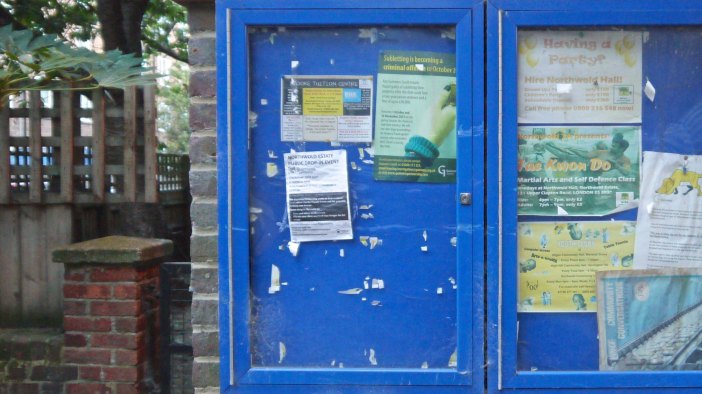

This crumpled piece of A5 paper, stuck to the outside of the notice board for Epping House, was the extent of notice residents received for the ‘consultation’ conducted by the firm of Newham Francis; while inside the cabinet a poster warns tenants that subletting their flats is now ‘illegal’, punishable by a two-year prison sentence and a fine of up to £50,000, and encourages them to end their tenancy.
Architects for Social Housing has been invited by residents to help them with their campaign to save their homes and their community. We will keep supporters abreast of events and how they can lend their support to campaign initiatives. The future of Northwold Estate is in all our hands.
Architects for Social Housing
Architects for Social Housing is a Community Interest Company (no. 10383452). Although we do occasionally receive minimal fees for our design work, the majority of what we do is unpaid and we have no source of public funding. If you would like to support our work, you can make a donation through PayPal:

Thanks for all your work
LikeLike
Hi. I am a resident of Northwold Estate and would like to make contact with other concerned residents. Can you please let me know how I can connect with the residents’ campaign group? (The group seems to have a strong presence on Twitter, but I don’t have a Twitter account!)
LikeLiked by 1 person
Come to the meeting on Friday 30 Sept and Saturday 1 Oct. We will be there. xxx
LikeLiked by 1 person
My sister lives in flat 1 fernhill house. She is an active campaigner with a strong social conscience. Her name is Deborah and I’m sure she would be happy to hear from other concerned residents.
LikeLiked by 1 person
Thank you for all your hard work. I thought Charities had rules and had to act charitably but this Guinness Partnership takes the biscuit
LikeLiked by 1 person
As a former housing officer for the estate under CCHT it’s a shame to see what has happened to the vibrant life of this fantastic estate. Unfortunately it’s also a shame to see that the things I prewarned residents about during the Guinness takeover are now coming to pass. Residents allowed themselves to be taken in by hollow glamour instead of listening to the inside warnings. The estate office going, and being turned into additional flats, was warned about years ago when residents were informed about Guinness’ agenda. Unfortunate.
LikeLiked by 1 person
Hello Rodrique, interesting comments. Would you be able to come and speak to residents at the next campaign meeting? Anything you can tell us about the conditions under which the stock transfer was made would potentially be useful. We’re interested in ascertaining whether demolishing the estate was an option when it was handed over, first to CCHT and then to the Guinness Partnership. If you can, let me know and I’ll keep you informed of when the next meeting is. Or join their campaign page on Facebook at: Love Northwold Homes, or our own page at: ASH (Architects for Social Housing).
LikeLiked by 1 person
I’m on the Stamford Hill estate, where there are persistent rumours that regeneration is in the pipeline.
It would be great to hear from individual tenants and tenants’ groups about their experience for the estate to start getting organised and fend off and foul play from Guinness.
I’m very keen to become involved with Northworld in your ongoing fight.
LikeLike